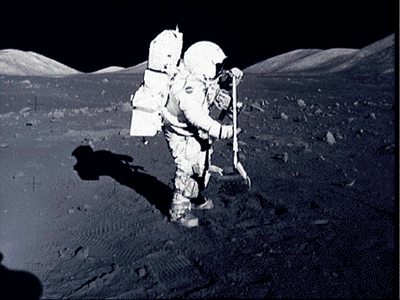End of an era or beginning of a new era?
12.12.2002
By: Avi Blizovsky

Astronaut Harrison Schmidt excavates the lunar soil
On December 11, 1972 - exactly thirty years ago - the astronauts of Apollo 17 directed their lunar module to land and began the last manned operation on the moon. Three days later, Eugene Kernan and Harrison Schmidt flew and reunited with their friend Ronald Evans in the command vehicle. They orbited the moon for another 48 hours, fired the engines and left the moon. They were the last so far.
During their short stay on the moon, Commander Kernan and geologist Schmidt traversed the length and breadth of the landing area, conducting a variety of geological experiments and collecting rocks to bring home.
Thirty years later there is interest again in returning to the moon. The European Space Agency plans to launch a robotic mission to the moon called SMART-1 this March. The National Research Committee called for organizing a robotic mission to the South Pole area - the Aitken Crater. China is planning a robotic mission to Mars by 2010 and building a manned outpost there between 2020 and 2030.
Scientists John Armstrong and Lloyd Wells of the University of Washington in Seattle and Julilemo Gonzalez of Iowa State University are calling for the renewal of manned missions to the moon to collect not moon rocks but rocks that came to the moon from Earth. Early in Earth's history, a shower of comets known as the Last Great Bombardment may have thrown pieces of the Earth's surface into space, some of this material may still be preserved today on the surface of the Moon. The rocks may contain fossilized evidence of early life on Earth, the researchers say. The scientists Kevin Zahnle (Kevin Zahnle) from NASA's Ames Research Center added that the studies of the rocks brought in Apollo 17 and the five flights that preceded it, helped to try techniques of searching for earth rocks on the moon. NASA geologist David McKee of the Johnson Space Center commented that to his knowledge no one has scanned the collection of these stones for terrestrial minerals.
